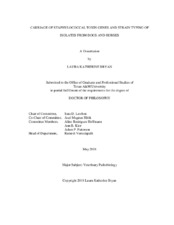| dc.description.abstract | Staphylococcus spp. are important causes of skin and systemic infections in people, dogs, and horses. In dogs, S. pseudintermedius is the most common cause of pyoderma. Staphylococcus aureus exfoliative toxin (ET) genes are associated with blistering skin lesions, and four purported exfoliative toxin genes have been reported in S. pseudintermedius: speta, siet, expA, and expB. Few studies have determined the prevalence of S. pseudintermedius ET genes in a large collection of canine isolates, and none have induced native ET proteins or determined if dogs produce anti-ET antibodies. The prevalence of speta, siet, expA, and expB in a collection of 500 clinical isolates from healthy and diseased dogs was 100, 99, 13, and 16%, respectively. A higher proportion of the dogs with pyoderma cultured expA-positive isolates when compared to healthy and diseased dogs. Native induction of EXPA and EXPB required incubation of liquid cultures with 10% CO₂, and both proteins were excreted in the culture supernatant. The SIET protein was not detected under these conditions. Canine sera contained antibodies against EXPA and EXPB. Whole genome sequencing was performed on a subset of 13 isolates. In the genomic sequences we obtained, the expA gene was consistently carried adjacent to a reverse transcriptase (Group II intron) and expB next to mobile element proteins that may facilitate horizontal transfer of the genes.
Staphylococcus aureus is associated with soft tissue and respiratory infections in horses. No studies have examined toxin and antimicrobial resistance characteristics of equine methicillin-sensitive (MSSA) and resistant (MRSA) isolates from the southern United States (US). The MRSA prevalence in a collection of 71 clinical isolates from horses and donkeys was 19%, with most being clonal complex 8. The most common MSSA was ST1, and 66% of all isolates carried the equine-adapted leucocidin PQ, the first instance of carriage outside of Europe. The toxin and resistance genes carried were diverse and included a new prophage-encoded variant of toxic shock syndrome toxin and one mupirocin and lincosamide-resistant isolate that has never been reported in a horse. We found that MSSA in addition to MRSA carry diverse virulence factors and can be pathogenic in horses. | en |


